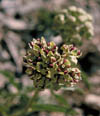
click picture for larger version
Common Name: Spider Milkweed
Other Common Names: Antelope Horns
Scientific Name: Asclepias asperula
Family: Milkweed Family (Asclepiadaceae)
Distribution: Intermountain West
Habitat: foothill sagebrush grassland, mountain brush, and pinyon-juniper
Habit: long-lived perennial herb from tuber
Height: 1-2'
Spread: 1-2'
Foliage Color: bright green
Leaves: lance-shaped, opposite, rough
Flower Color: purple and green
Flower Form: intricate flowers 0.5" in diameter in balls at the ends of long stems
Flowering Season: midsummer
Cultural Requirements: Requires full sun and well-drained soils. Fully cold-hardy. Very drought hardy (i.e., needs no supplemental water after establishment on the Wasatch Front), but somewhat tolerant of overwatering. Grows well in the company of native perennial bunchgrasses. Probably requires at least two years to reach flowering size.
Culture: The large plumed seeds are borne in typical milkweed pods. They are nondormant at dispersal in late August and germinate well only at the relatively high temperatures of early autumn. Readily produced as container stock. We have not tried direct seeding. Unlike the common pink-flowered milkweed of moister habitats, this species is not rhizomatous and not invasive.
Uses and Notes of Interest: This common but usually overlooked plant has some of the most truly unusual flowers we have ever seen. They also have an unforgettable, heavy, sweet fragrance. The foliage is bright green when most of the grasses that are its companions in the foothills are already straw-colored. We have not yet grown this plant to maturity in cultivation and know of no one who has tried it before.